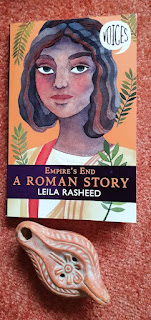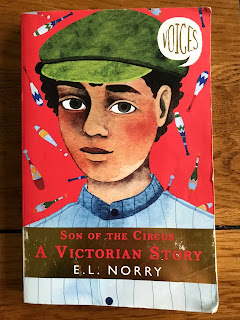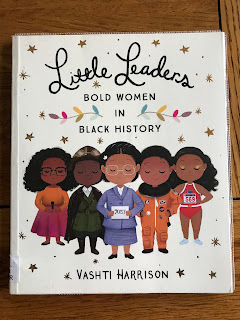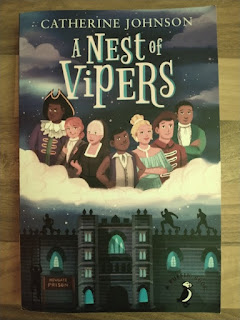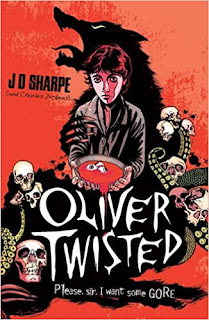Meet the
Time Tunnellers! We are five children's book authors who write historical novels.
Ally Sherrick
Ally’s dream job as a child was to be an Egyptologist and dig up mummies and
treasure. Her favourite subjects at school were English and History and she
loved nothing better in the holidays than exploring ruined castles and decaying
mansions and imagining what it must have been like to live in them with no
electricity or hot and cold running water.
After studying for a BA in medieval history and French at the University of
Newcastle Upon Tyne, she pursued a successful career in public relations and
marketing. Then, in 2010, she took a break to study for an MA in Writing for
Children which led to a publishing deal with award-winning children’s
publishers, Chicken House Books.
Books:
BLACK POWDER, is about a boy caught
up in the infamous Gunpowder Plot. (Aug 2016.)
Ally’s debut won the 2017
Historical Association’s Young Quills Award and the North Somerset Teachers’
Book Award 2017.
THE BURIED CROWN is set during
World War Two and links to the discovery of the celebrated Sutton Hoo
Anglo-Saxon ship burial. (Apr 2018.)
THE QUEEN’S FOOL is a Tudor-set
adventure which sees
Cat
Sparrow travel to the wondrous Field of Cloth of Gold in search of her sister.
(Feb 2021.)
All three books are published by Chicken House.
Ally is currently working on a new book for Chicken House due for
publication in early 2023.
Ally is married and lives with her husband and assorted garden wildlife in
West Surrey.
Why I chose this
hat!
It’s
a crown really. It might even be the
crown from my story World War Two set adventure The Buried Crown. If it is then it’s very old and belonged to a
famed Anglo-Saxon warrior who was rewarded with it and the kingdom by a
grateful king for saving him and his people from the ravages of a
treasure-thieving dragon. It has a runic inscription on it which reads: ‘He who
has me has the kingdom’. And it might, just might, have a touch of magic welded
into it too. But to find out more you’ll have to read the book!
Where would I
time travel to?
That’s
such a tough question! There are so many possible destinations to choose from.
But top of my current time-travelling bucket-list is Holy Island, Lindisfarne
in Northumbria, a magical place connected to the mainland by a causeway that
disappears under water when the tides come in. The time I’d pick is just before
the start of the first Viking raid in 793. It would give me the chance to
admire the wonderful Lindisfarne Gospels in the monastery scriptorium where
they were produced, interview the monks about how they made such beautiful and
inspired art and meet a fearsome Viking warlord or two. Though I probably
wouldn’t hang around for too long once they started waving their swords and
battleaxes and demanding treasure with menaces!
Find
out more about Ally:
Website: allysherrick.com
twitter: @ally_sherrick
Susan Brownrigg
Susan wanted to be an author for a very long time! So in the meantime she
did lots of other jobs. A graduate in journalism, film & broadcasting,
Susan worked on a series of weekly local newspapers, then was promoted to sub
editor where she came up with headlines, checked articles for accuracy and laid
out pages. Susan then switched careers to heritage and wildlife education,
working at a zoo, science discovery centre and for the National Trust. Her
duties included looking after animals and living history. Until recently she
was Learning Manager at a museum and gardens on the grounds of a former
medieval priory. She now works as a library information assistant.
Books:
GRACIE FAIRSHAW AND THE MYSTERIOUS
GUEST A mystery adventure set in Blackpool. Can Gracie work out which of
the guests has taken Ma, as the clock ticks down to the 1935 Illuminations
switch-on? (Jul 2020)
KINTANA AND THE CAPTAIN’S CURSE A treasure hunt adventure
with lemurs and magic set in Madagascar during the golden age of piracy. (Jul 2021)
GRACIE FAIRSHAW AND THE TROUBLE AT THE TOWER Accidents, pranks
and poison pen letters - someone
is trying to spoil the Blackpool Tower Children's Ballet's Christmas show. Gracie
and her friends must stop the saboteur before their final act! Published Oct 7, 2021.
All three books are published by Uclan Publishing.
Susan lives with her husband in Skelmersdale, Lancashire.
Why I chose this
hat!
This
is a 1930s style felt cloche hat! In my book, Gracie Fairshaw and the
Mysterious Guest, Gracie’s Ma vanishes. Gracie finds Ma’s hat, squashed on
the floor along with her handbag, and determines to seek out more clues,
assisted by her younger brother, George, new friends Tom and Violet, and
Phyllis the maid. I love the fashions of the 1930s and wish we all still wore
hats like this! If you want to know how Gracie works out which guest is
responsible for her disappearance and if she can rescue her in time you’ll have
to read the book!
Where would I
time travel to?
I
am fascinated by the story of the thylacine (the Tasmania Tiger.) It is
extinct, though every so often stories pop up of sightings. The thylacine was a
semi-nocturnal large carnivore that looked like a dog/wolf but was a marsupial
– so it had a pouch! It had stripes on its hide – hence the nickname.
Originally, they were widespread across continental Australia. There numbers
declined due to habitat destruction, introduced disease from wild dogs, and
hunting by humans. The last known thylacine, Benjamin, dies at Beaumaris Zoo,
Hobart, in 1936. If I could go back in time, I would love to see them roaming
wild as darkness beckons.
Find
out more about Susan:
Website: susanbrownrigg.com
twitter: @suebmuseum
Instagram: @susanbrownrigg
Barbara Henderson
Barbara Henderson moved to Scotland 30 years ago and has
somehow since acquired an MA in English Language and Literature, a husband,
three children and a shaggy dog along the way. Her day job as a drama teacher
gives her ample opportunity to try out her story ideas on youngsters.
Based in Inverness, Barbara is the author of six acclaimed
novels for children. Five of them are historical fiction and all are published
by Cranachan. She has won several national and international writing
competitions and been shortlisted for both the Crystal Kite and the Kelpies
Prize.
This year has seen the publication of her new Viking
adventure The Chessmen Thief, an origin story for the famous Lewis Chessmen,
and Scottish by Inclination, Barbara’s first adult non-fiction title.
She says: ‘To me, the past is the most interesting country
of all. I could not be more excited to be a Time Tunneller.’
Books:
FIR FOR LUCK
Highland Clearances novel based on real events in Sutherland, Scotland. (Sep 2016)
PUNCH Victorian
boy-on-the-run tale based on real events in 1889 and set against a lively
backdrop of travelling entertainers. (Oct 2017)
WILDERNESS WARS
A contemporary eco-thriller for children asking: 'What if Nature fights back?' (Aug 2018)
BLACK WATER
A smuggling novella based on real events and featuring the poet Robert Burns.(Oct 2019)
THE SIEGE OF CAERLAVEROCK
A medieval castle adventure based on the real-life siege in the year 1300. (Aug 2020)
The Siege of Caerlaverock has been shortlisted for the Historical Association's Young Quills Award 2021.
THE CHESSMEN THIEF
A Viking adventure and inventive origin story for the famous Lewis Chessmen. (Apr 2021)Barbara's childrens books are published by Cranachan.
Why I chose this hat!
Well, with my head firmly in the late Viking age, I had to
choose a Viking helmet, right? What most people don’t realise is that Viking
helmets did NOT in fact have horns – the Norsemen used hollowed-out horns for
drinking out of, though.
Where I would time travel to?
I always think I would like to experience the Middle Ages –
I love so much about that period – the poetry and the architecture, the
literature and the pageants with live theatre (as a drama teacher I really
enjoy theatre). I adore seeing illuminated manuscripts too, and knights and
jousting just add to the magic. People in the Middle Ages loved stories and
many of our legends started then. However, I would avoid the Crusades and the
wars, and I’d run from the plague – I’m too much of a wimp, I’m afraid!
Find out more about Barbara:
Website: barbarahenderson.co.uk
twitter @scattyscribbler
Instagram @scattyscribbler
Facebook: barbarahendersonwriter
Catherine RandallCatherine’s love of history began at the age of 6 months,
when her history-teacher mother took her into lessons in her pram. After that
there was no looking back as family holidays involved lots of castles and
classical ruins, with her mother often able to provide a running commentary on
the people who’d once lived there. Catherine also devoured all the children’s
historical fiction she could find, as well as writing her own stories (often
about families with large numbers of children) because writing had become a
passion from the age of six.
After studying history at university (no surprise there),
Catherine worked as an editor in publishing before taking time out to bring up
her three children. The urge to write wouldn’t go away and when her youngest
child started school, she did an MA in Children’s Literature which confirmed
that writing for children was what she really wanted to do.
Books:
THE WHITE PHOENIX Catherine's debut children's book is set in London in 1666, it features
forbidden friendship, prejudice, plague, a bookshop and of course the Great
Fire of London. (Aug 2020)
The White Phoenix has been shortlisted for the Historical Association's Young Quills Award 2021.
Catherine is currently working on her second children’s
historical novel.
Catherine is very proud of coming from Shropshire, but now
lives with her husband and varying numbers of grown-up children in Teddington,
Middlesex.
Why I chose this hat!
A few years ago, while I was researching the Great Fire of
London for my first novel, I realised that I knew a ridiculous amount about the
subject and wanted to share it even before the novel was finished. A kind lady
at the local theatre made me a seventeenth-century costume (including this cap)
and also produced some aprons and cloaks. Now when I visit schools to talk
about the Great Fire, I can go in costume and the children can dress up too. I
love talking to children about the Great Fire!
Where would I time travel to?
I’ve spent so much time imagining I’m in seventeenth-century
London that I just have to choose that. Although London in the 1660s was noisy,
smelly and dirty, it was also a very vibrant, colourful place, with lots of
interesting people busy discovering exciting new things about science, art and
astronomy, and then discussing it together over meals of pies and oysters.
However, I have to say that the 1660s would only be fun if you weren’t poor,
and it would also be better to be a boy than a girl. Girls in 1660s London
probably had more freedom than they did in some later periods, but they were
still not treated as equals with boys. This is one of
the reasons why Lizzie in The White Phoenix has to fight so hard to save her
bookshop.
Find out more:
Website: catherinerandall.com
twitter: @Crr1Randall
Jeannie Waudby Jeannie grew up on a little island in Hong
Kong, which was a leprosy treatment centre. Almost all the buildings
were quite new but there was a tiny old temple, an original hamlet and
several centuries-old graves. Maybe because none of the original
inhabitants now lived on the island, Jeannie used to wonder about the
people who had been there long ago. Going into old buildings still
sparks this fascination for her, and is probably behind the story she is
currently working on. Jeannie is half Scottish and half English and
this story is set in the Highlands and near London, where Jeannie lives.
Books:
ONE OF US (Chicken House) is a
contemporary YA story (12+), set in a parallel reality, so although time
is not going backwards, it shifts sideways.
ONE OF US was shortlisted
for the Bolton Children’s Fiction Award and the Lancashire Book of the
Year 2016.
It has been adapted by Mike Kenny as a play in the Oxford
Playscripts series, and is also an audiobook read by Melody Grove.
Why I chose no hat!
I
am wearing a shawl rather than a hat, because when the Clearances force
my main character to leave the Highlands in 1848, she takes with her a
shawl she made herself. In the background you can see the current
Inverness harbour, taken from the site of the old Thornbush Pier, which
is where the Steam Packet sailed from Inverness to London before the
railway.
Where would I time travel to?
I
wouldn’t like to be limited to just one time if I could time travel! I
would love to see what life was like when my parents were young. I think
I would want to be able to come back whenever I wanted, and that being
the case, I would love to see London in the mid nineteenth century and
to travel across oceans on a sailing ship. I’d like to make the journey
my character makes – four days in a steam ship down the east coast of
Britain – a journey I’ve made so many times by rail. Whenever I visit a
grand old house, I wish I could time travel back to
meet the servants.
Find out more
Website: jeanniewaudby.com
twitter: @jeanniewaudby









